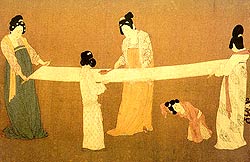After the Han Dynasty and the Three Kingdoms Period (220-265), the Jin Dynasty (265-420), the Southern and Northern Dynasties (420-589) and the Sui Dynasty (581-618) were succeeded by the Tang Dynasty, established by Li Yuan in 618. Li Shimin, or Emperor Taizong (r. 626-649), son of Li Yuan, adopted a series of liberal policies, pushing the prosperity of China’s feudal society to its peak: Agriculture, handicrafts and commerce flourished; technologies for textile manufacturing and dyeing, pottery and porcelain production, smelting and shipbuilding were further developed; and land and water transportation greatly improved. By the 660s, China’s influence had firmly taken root in the Tarim and Junggar basins and the Ili River valley, and even extended to many city-states in Central Asia. During this period, extensive economic and cultural relations were established with many countries, including Japan, Korea, India, Persia and Arabia.
(China.org.cn)


